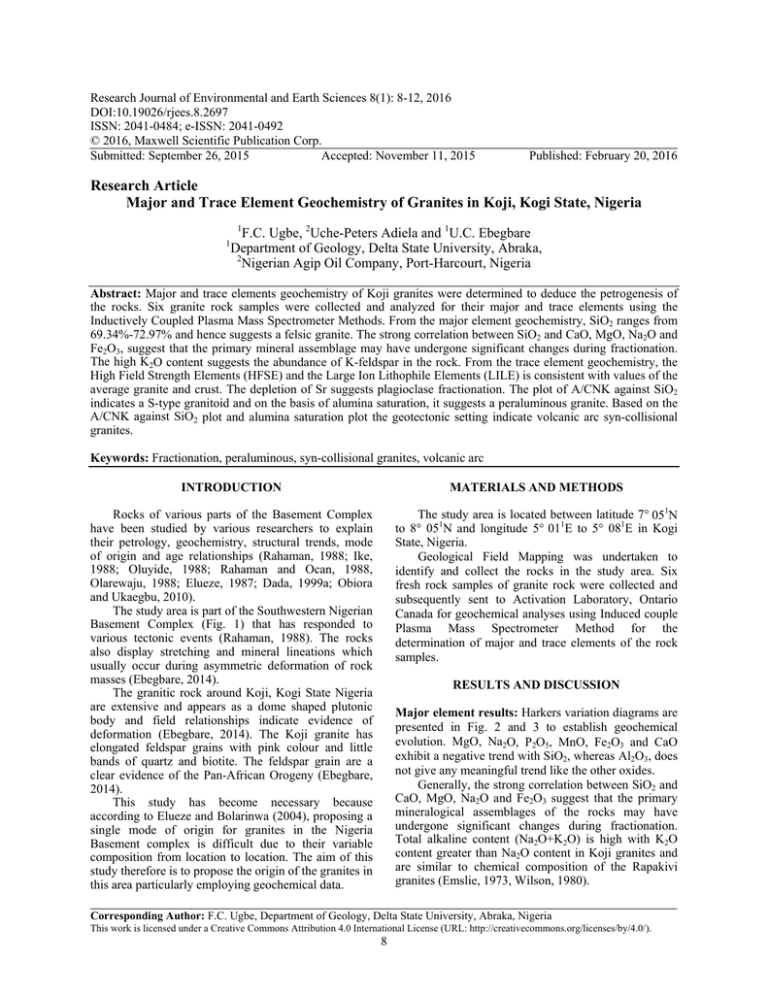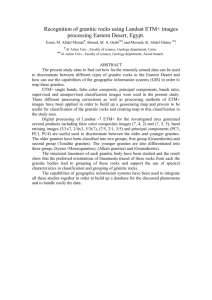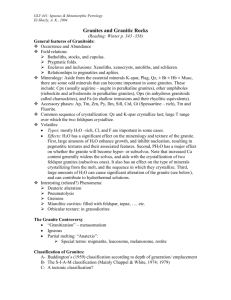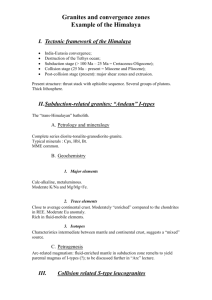Research Journal of Environmental and Earth Sciences 8(1): 8-12, 2016 DOI:10.19026/rjees.8.2697
advertisement

Research Journal of Environmental and Earth Sciences 8(1): 8-12, 2016 DOI:10.19026/rjees.8.2697 ISSN: 2041-0484; e-ISSN: 2041-0492 © 2016, Maxwell Scientific Publication Corp. Submitted: September 26, 2015 Accepted: November 11, 2015 Published: February 20, 2016 Research Article Major and Trace Element Geochemistry of Granites in Koji, Kogi State, Nigeria 1 1 F.C. Ugbe, 2Uche-Peters Adiela and 1U.C. Ebegbare Department of Geology, Delta State University, Abraka, 2 Nigerian Agip Oil Company, Port-Harcourt, Nigeria Abstract: Major and trace elements geochemistry of Koji granites were determined to deduce the petrogenesis of the rocks. Six granite rock samples were collected and analyzed for their major and trace elements using the Inductively Coupled Plasma Mass Spectrometer Methods. From the major element geochemistry, SiO2 ranges from 69.34%-72.97% and hence suggests a felsic granite. The strong correlation between SiO2 and CaO, MgO, Na2O and Fe2O3, suggest that the primary mineral assemblage may have undergone significant changes during fractionation. The high K2O content suggests the abundance of K-feldspar in the rock. From the trace element geochemistry, the High Field Strength Elements (HFSE) and the Large Ion Lithophile Elements (LILE) is consistent with values of the average granite and crust. The depletion of Sr suggests plagioclase fractionation. The plot of A/CNK against SiO2 indicates a S-type granitoid and on the basis of alumina saturation, it suggests a peraluminous granite. Based on the A/CNK against SiO2 plot and alumina saturation plot the geotectonic setting indicate volcanic arc syn-collisional granites. Keywords: Fractionation, peraluminous, syn-collisional granites, volcanic arc INTRODUCTION MATERIALS AND METHODS Rocks of various parts of the Basement Complex have been studied by various researchers to explain their petrology, geochemistry, structural trends, mode of origin and age relationships (Rahaman, 1988; Ike, 1988; Oluyide, 1988; Rahaman and Ocan, 1988, Olarewaju, 1988; Elueze, 1987; Dada, 1999a; Obiora and Ukaegbu, 2010). The study area is part of the Southwestern Nigerian Basement Complex (Fig. 1) that has responded to various tectonic events (Rahaman, 1988). The rocks also display stretching and mineral lineations which usually occur during asymmetric deformation of rock masses (Ebegbare, 2014). The granitic rock around Koji, Kogi State Nigeria are extensive and appears as a dome shaped plutonic body and field relationships indicate evidence of deformation (Ebegbare, 2014). The Koji granite has elongated feldspar grains with pink colour and little bands of quartz and biotite. The feldspar grain are a clear evidence of the Pan-African Orogeny (Ebegbare, 2014). This study has become necessary because according to Elueze and Bolarinwa (2004), proposing a single mode of origin for granites in the Nigeria Basement complex is difficult due to their variable composition from location to location. The aim of this study therefore is to propose the origin of the granites in this area particularly employing geochemical data. The study area is located between latitude 7° 051N to 8° 051N and longitude 5° 011E to 5° 081E in Kogi State, Nigeria. Geological Field Mapping was undertaken to identify and collect the rocks in the study area. Six fresh rock samples of granite rock were collected and subsequently sent to Activation Laboratory, Ontario Canada for geochemical analyses using Induced couple Plasma Mass Spectrometer Method for the determination of major and trace elements of the rock samples. RESULTS AND DISCUSSION Major element results: Harkers variation diagrams are presented in Fig. 2 and 3 to establish geochemical evolution. MgO, Na2O, P2O5, MnO, Fe2O3 and CaO exhibit a negative trend with SiO2, whereas Al2O3, does not give any meaningful trend like the other oxides. Generally, the strong correlation between SiO2 and CaO, MgO, Na2O and Fe2O3 suggest that the primary mineralogical assemblages of the rocks may have undergone significant changes during fractionation. Total alkaline content (Na2O+K2O) is high with K2O content greater than Na2O content in Koji granites and are similar to chemical composition of the Rapakivi granites (Emslie, 1973, Wilson, 1980). Corresponding Author: F.C. Ugbe, Department of Geology, Delta State University, Abraka, Nigeria This work is licensed under a Creative Commons Attribution 4.0 International License (URL: http://creativecommons.org/licenses/by/4.0/). 8 Res. J. Environ. Earth Sci., 8(1): 8-12, 2016 Fig. 1: Geologic map of Nigeria showing study area Fig. 2: Major element (Al2O3, Fe2O3, MnO, MgO, CaO, Na2O against SiO2) Harkers plot for granite from the study area Fig. 4: Plot of K2O vs Na2O diagram subdiving the alkaline magma series into K-series, high K-series and Na series (after Middlemost, 1975) A plot of K2O against Na2O suggests a magma rich in Potassium as shown in Fig. 4. High K2O content suggest the preponderance of microcline in the granites (Olarewaju, 1988). Silica is most abundant ranging from 69.34-72.97% and hence suggests a felsic granite. Trace element geochemistry: Trace elements are those which occur in very low concentrations in common rocks usually <0.1% by weight. Unlike major elements, Fig. 3: Selected major element (K2O, TiO, P2O2, against SiO2) Harkers plot for granite from the study area 9 Res. J. Environ. Earth Sci., 8(1): 8-12, 2016 Table 1: Major element geochemistry Sample 1 SiO2 72.97 Al2O3 14.07 0.86 Fe2O3 MnO 0.011 MgO 0.02 CaO 0.09 Na2O 1.91 9.48 K2O 0.028 TiO2 0.02 P2O5 LOI 0.10 TOTAL 99.55 Sample 2 71.12 12.76 2.12 0.075 0.74 1.66 2.89 7.33 0.636 0.21 0.25 99.79 Sample 3 70.45 12.43 1.98 0.092 0.69 3.41 1.84 6.43 0.035 0.10 0.31 98.78 Sample 4 70.19 13.30 2.01 0.083 0.68 2.19 3.11 5.26 0.132 0.22 1.22 98.39 Sample 5 69.34 15.01 1.02 0.029 0.43 1.78 2.36 7.09 0.030 0.03 1.46 98.58 Sample 6 70.09 13.35 2.93 0.042 0.22 1.98 3.14 6.98 0.120 0.05 0.10 100.002 Table 2: Trace element geochemistry Sample 1 Bc 2 Be 2 V <5 Cr <20 Co <1 Ni <20 Cu <10 Zn <30 Ga 23 Ge 3 As <5 Rb 768 Sr 19 Y 50 Zr 67 Nb 67 Mo <2 Ag 1.2 In <0.2 Sn 3 Sb <0.5 Cs 4.5 Ba 34 Hf 2.6 Ta 4.3 W 3 Ti 3.2 Pb 85 Bi <0.4 Th 15.7 U 24.8 Sample 2 7 7 <5 <20 <1 <20 <10 <30 21 2 <5 763 18 49 62 50 <2 1.2 <0.2 5 <0.5 5.0 30 2.4 4.0 4 3 85 <0.4 15 24.6 Sample 3 6 5 <5 <20 <1 <20 <10 <30 22 3 <5 759 19 50 66 66 <2 1.0 <0.2 2 <0.5 4.7 33 2.6 4.2 3 3.3 86 <0.4 15.3 24 Sample 4 6 5 <5 <20 <1 <20 <10 <30 23 3 <5 769 17 48 69 68 <2 0.9 <0.2 3 <0.5 4.8 31 2.3 4.4 3 3.4 87 <0.4 15.4 24.7 Sample 5 4 3 <5 <20 <1 <20 <10 <30 21 2 <5 752 20 50 64 65 <2 1.1 <0.2 4 <0.5 4.9 35 2.3 4.3 2 3.2 86 <0.4 15.4 24.8 Sample 6 2 3 <5 <20 <1 <20 <10 <30 24 3 <5 768 19 46 67 67 <2 1.1 <0.2 4 <0.5 4.2 34 2.6 4.0 1 3.1 85 <0.4 15.1 24.8 trace elements tend to concentrate in fewer minerals and are therefore more useful in formulating models for magmatic differentiation and in some cases, in predicting the source of a particular magma (Taylor, 1965) (Table 1). Trace elements concentration of the granites in the study area is shown in Table 2. The values of the High Field Strength Elements (HFSE) (U, Be, Sn, Mo, W, Zr, Nb, Hf, Ta) and Large Ion Lithophile Elements (LILE) (Rb, Cs, Ba, Pb, Sr, Th) of the granitic rocks compared well with the values of average granite and crust. The enrichment of some of the HFSE like Nb, Zr and U in the granitic rocks suggest volatile concentrations during the evolution of granites (Onyeogocha, 1984). Of all the trace elements, Rb and Pb show abnormally high values compared to average granite and crust. This is consistent with the study of Elueze (1987). Figure 5 shows some trace elements plotted against SiO2 in the Harker’s variation diagram. The plots show that strong correlations exist between SiO2 and these elements. The granites are enriched in Rb, Pb, Zr, Ba, Sr and Y but depleted in Be, Hf, Ag, Mo, As, Co, Cr and V and this supports a felsic magma source. The elemental ratio of Koji granites are shown in Table 3. Pearce et al. (1984) introduced a geochemical method to characterize the tectonic environment of granitic rocks and to demonstrate crystal fractionation of feldspar and biotite. Figure 6 shows the plot of Sr and Ba against Rb/Sr ratio. A very good negative trend is observed particularly in the Sr vs Rb/Sr diagram. The Rb/Sr ratio ranges from 37.6-45.2, The Ba/Sr ratios ranges from 1.666-1.823, Ba/Rb ratio ranges from 0.039-0.046. The limited variation of the incompatible element ratios of Rb/Sr , Ba/Sr and Ba/Rb of the granitic rocks suggest partial melting. 10 Res. J. Environ. Earth Sci., 8(1): 8-12, 2016 Table 3: Elemental Ratio of Koji granite Sample 1 Rb/Sr 40.4 Ba/Rb 0.044 Ba/Sr 1.789 A/CNK 1.225 A/NK 1.237 Sample 2 42.2 0.039 1.666 1.436 1.248 Sample 3 39.9 0.043 1.736 1.064 1.503 Sample 4 45.2 0.040 1.823 1.259 1.589 Sample 5 37.6 0.046 1.75 1.336 1.588 Sample 6 40.42 0.044 1.789 1.103 1.319 Fig. 5: Ba, Rb, Sr, Zr, U, Sn plotted against SiO2 Fig. 7: A/CNK versus SiO2 Fig. 6: Sr and Ba against Rb/Sr ratio With Ba/Sr greater than 1 and Ba/Rb less than 1, fractional crystallization will result in decreasing Sr and Ba and enhancement of Rb. The depletion of Sr suggests plagioclase fractionation. The general trends of these trace elements also suggest that fractionation was dominated by alkali feldspar and biotite. Figure 7 and 8 show plot of A/CNK against SiO2 in which the granites plot as S- type granitoids while on the basis of alumina saturation as earlier proposed by White and Chappell (1988) the Al2O3/Na2O+K2O against Al2O3/(CaO+Na2O+K2O) diagram indicates that the granitic rocks plot predominantly in the peraluminous field. The peraluminous granites are thought to be generated by partial melting of Fig. 8: A/NK versus A/CNK (after Maniar and Piccolo, 1989) metasedimentary rocks as a result of thermal relaxation of the orogeny. CONCLUSION Geochemical characteristics show that the Koji granites correspond to the S-type granitoids because of their high SiO2 composition (69.34-72.99), largely peraluminous relatively potassic and their geotectonic settings indicate volcanic arc and syn-collisional granites. High Rb/Sr ratios (40.4-37.6) and low Ba/Sr ratio (1.666-1.833) indicate high fractionation 11 Res. J. Environ. Earth Sci., 8(1): 8-12, 2016 associated with magmatic differentiation. Furthermore, rare earth elements studies is recommended to gain more insight as to the petrogenesis of the granites. Olarewaju, V.O., 1988. Petrology and Geochemistry of the charnockitic and Associated granitic rocks of Ado-Ekiti-Akure area, southwestern Nigeria. In: Oluyide, P.O., W.C. Mbonu, A.E. Ogezi, I.G. Egbuniwe, A.C. Ajibade and A.C. Umeji, (Eds.): Precambrian Geology of Nigeria. Geological Survey of Nigeria, pp: 129-143. Oluyide, P.O. 1988. Structural Trends in the Nigerian Basement Complex. In. Oluyide, P.O., W.C. Mbonu, A.E. Ogezi, I.G. Egbuniwe, A.C. Ajibade and A.C. Umeji (Eds.): Precambrian Geology of Nigeria, pp: 93-98. Onyeogocha, A.C., 1984. Petrology and geologic history of northwestern Akwanga area in Northern Nigeria. J. African Earth Sci., 2(1): 41-50. http://www.sciencedirect.com/science/article/pii/08 99536284900186. Pearce, J.A., N.B. Harris and A.G. Tindle, 1984. Trace element discrimination diagrams for the tectonic interpretation of granitic rocks. J. Petrol., 25(4): 956-983. http://petrology.oxfordjournals.org/ content/25/4/956.abstract. Rahaman, M.A., 1988. Recent advances in the study of the basement complex of Nigeria. Symposium on the Geology of Nigeria, Obafemi Awolowo University, Nigeria. Rahaman, M.A. and O.O. Ocan, 1988. The nature of Granulite facies metamorphism in Ikare area, Southwestern Nigeria. In: Oluyide et al. (Eds.): Precambrian Geology of Nigeria. Publ Geol Surv Nigeria, Kaduna, pp: 157-163. Taylor, S., 1965. The application of trace element data to problems in petrology. Phys. Chem. Earth, 6: 133-213. http://adsabs.harvard.edu/abs/1965PCE .....6..133T. White, A.J.R. and B.W. Chappell, 1988. Some supracrustal (S-type) granites of appalachian fold belt. Trans. R. Soc. Edinburgh, Earth Sci., 79: 169-181. Wilson, M.R., 1980. Granite types in Sweden. Geologiska, 102(2): 167-176. http://www. tandfonline.com/doi/abs/10.1080/11035898009450 896?journalCode=sgff19 REFERENCES Dada, S.S., 1999a. Geochemistry and petrogenesis of the reworked Archean gneiss complex of North Central Nigeria: Major and trace element studies on Kaduna amphibolites and migmatitic gneisses. Global J. Pure Appl. Sci., 5&4: 535-543. Ebegbare, U.C., 2014. Petrography and Geochemistry (Major and Trace Element) of the Exposed Granite in Koji, Bassa, L. G. A., of Kogi State, Nigeria. Unpublished, B. Sc. Thesis, Delta State University, Abraka, pp: 52. Elueze, A.A., 1987. Geochemistry of the Ilesha granite in the Basement complex of Southwestern Nigeria. Precambrian Res., 19(2): 1967-1968. http://www. sciencedirect.com/science/article/pii/03019268829 00572. Elueze, A.A. and A.T. Bolarinwa, 2004. Petrochemistry and Petrogenesis of granitic gneisses of Abeokuta area, Southwestern Nigeria. Global J. Geol. Sci., 40(1): 1-8. http://www.ajol.info/index.php/jmg/ article/view/18803. Emslie, R.F., 1973. Some chemical characteristics of anorthosite suites and their significance. J. Earth Sci., 10(1): 54-71. http://www.nrcresearchpress. com/doi/abs/10.1139/e73-005?journalCode = cjes #.Vk1jrNIrJkg. Ike, E. C. 1988. Late Stage Geological phenomena in the Zaria Basement granites. Precambrian Geology of Nigeria, Geological Survey of Nigeria Spec. Pub, pp: 83-89. Maniar, D. D. and Piccolo, P. M., 1989. Tectonic Discrimination of granitoids. Geological Society of America Bulletin. 101: 635-643 Middlemost, E. A. K., 1975. The basalt clan. Earth Science Reviews. 11, 337-363 Obiora, S.C. and V.U. Ukaegbu, 2010. Preliminary investigation of the petrogenesis and geotectonic setting of the Precambrian basement complex rocks around northcentral Nigeria using trace and rare earth elements geochemisty. J. Mining Geol., 46: 127-137. 12





